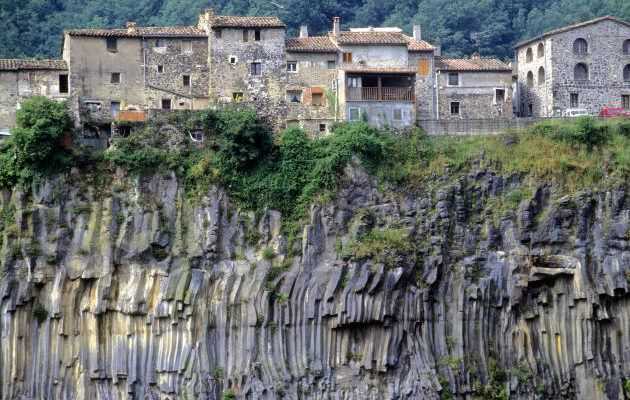ReportingLava as a row in monumental columns or whose traces are still visible in the bed of a river: in the natural park of La Garrotxa, in Spain, the landscape was shaped by volcanoes. Like the life of the inhabitants.
It’s raining hard, but from the expressway that leads to Olot, Spain, a perched village looms on a rocky promontory. In the distance, the stone houses give the impression of being hung on a cliff with impressive geometric lines. A few hours later, we learn the name of this curiosity: the basaltic organs of Castellfollit de la Roca. A geological formation resulting from the eruption of several volcanoes over 10,000 years ago.
The lava, on cooling, fractured to form a line of regular columns reminiscent of the keys of an organ. To enjoy these volcanic landscapes and the belvedere over the Fluvia valley and the Haute Garrotxa, you used to have to take small winding roads and drive several hours. Today, “the garrotxes”, the rough and rugged lands (in Catalan), are only an hour and a half from Barcelona.
Transformed into a quarry between 1966 and 1986, the Croscat was used for the extraction of volcanic rocks before becoming a nature reserve.
It is one of the most protected volcanic areas in Spain since the creation of the Garrotxa Natural Park in 1982, or 15,309 hectares comprising 28 nature reserves and 11 municipalities. The largest is Olot, with its 35,000 inhabitants. “ Here, the volcanoes are internalized by the population, they are part of everyday life and part of the cultural heritage. The Montsacopa is in the center of the village, from its crater you can see the whole town. There is a close, familiar relationship with this volcano. Every day, old and young go up there to play sports, or enjoy the view of the valley ”, explains tourist guide Mireia Tresserras. From the chapel of Sant Francesc built in 1817 on its summit, one dominates the old town but also the Bisaroques, the smallest of the four volcanoes of Olot and the Montolivet. In the distance again, the peak of Canigou (2,785 m) and Puigsacalm (1,512 m).
Sleeping volcanoes but not totally extinct. The volcanic area completed its formation 11,500 years ago, the date of the last Croscat eruption (in the municipality of Santa Pau). Transformed into a quarry between 1966 and 1986, it was used for the extraction of volcanic rocks before it became a nature reserve. It is one of the youngest volcanoes in La Garrotxa, along with Rocanegra. And one of the peculiarities of the province.
World Cup
The extractions carved out a front 100 meters high drawing a steep slope where the black and purple sand of the volcanic rock mingle with the luminous green of the moss and trees. We can see the different layers of stratification of the lava and perhaps more the contrast between the hardness of the stone and the softness of the vegetation. A journey through time that we extend by following the circuit of the volcanoes of the natural park. A four-hour loop allows you to cross these lunar landscapes and discover the Fageda d’en Jorda, the beech forest that grew on the Croscat lava flow, or the Santa Margarida volcano and its circular crater where nestles a hermitage of the XIe century.
You have 59.06% of this article left to read. The rest is for subscribers only.
